The first time I heard the name ‘Ram’ was as a child when my aunts would recite the Ram Raksha at the drop of a hat. Everyone in my home, especially from my father’s side, were expert at this. Ram Raksha, dedicated to Lord Ram and believed to be written by sage Vishwamitra, is the tried and tested prayer for protection against all kinds of misfortunes, fears, bad luck, evil eye, black magic, and most importantly, ghosts and witchcraft (the Konkan coastline people take their ghosts very seriously and believe whole-heartedly not just in normal ghosts but their various relatives – ghosts of children, of unmarried persons, of young widows, of those who committed suicide, and so on, each with a specific name of their own!). They put the fear of ghosts in their kids too – we were told to chant Ram, Ram, Ram, if we got up in the night for a drink of water and stumbled through the darkness into the kitchen. It would keep any loitering banshee out of our way. Once, after a visit to the family kuldevta Mangueshi (Shiva) temple in Goa, I asked my grandmother who had come with us, why should I not say Shiva, Shiva, Shiva if I found myself in a bad spot, after all Shiva was the family deity. And all I got for my trouble was a whack on the back and a yell, never say Shiva, Shiva in the dark, all the ghosts in hell will come at you!
Bharat Milap by Ravi Varma. From the collection of Chandrashekhar Patil, who put up a most unusual exhibition at the Ghat on the Vishwamitri River near the Kala Ghoda bridge on January 22.
In later years in school, Amar Chitra Katha ‘comics’ brought many characters of the Ramayana alive, with stories about major and minor happenings in their lives. Not that there were many multi-faceted characters therein – Dashrath, Ram, Hanuman, Ravan, Luv and Kush, Valmiki, Sita, Mandodari, Vibhishan – all largely black and white, hardly any greys. I believe that much later a 6-volume set covering Bala Kand, Ayodhya Kand, Aranya Kand, Kishkindha Kand, Sundara Kand, and Yuddha Kand was also published. It must have explored several quiet nuances of the characters that peopled the epic. In 1993, a team of Japanese animators brought out Ramayana: The Legend of Prince Rama, a sensitively made and technically iconic movie of over two hours, presented in English, Hindi and Japanese. With delightful and powerful visuals, it is not an easy film to forget. I remember taking my boys to see it at the Aradhana talkies in my small town. For some strange reason the Indian Government banned it for a while, but then cleared it for general viewing.
Sita spots the Golden Deer. A printed Diwali Greeting Card collected by Patil during the exhibitions of such items along the Sursagar just before Diwali in the decades gone by.
When I was studying dance, Prof. C V Chandrasekhar had choreographed the dance drama Bhoomija, centered around the life of Sita. The young princess strolling with her sakhis in the palace gardens on the morning of her swayamvara, spots Ram in another part of the garden and falls in love with him. She gets agitated at her father for organizing her swayamwara that does not allow her choice in the matter of who she marries, and hopes fervently that Ram would be able to lift and string Shiva’s bow and so win her hand. Well, he not only does that but also gifts her 14 years of vanvaas, a kidnapping by Ravan, a number of tests by fire, and finally a banishment into the forest again when he chooses to believe a dhobi’s rant. And talking of dhobis, one day returning home in an auto, I was greeted by my dhobi lady armed with a bundle of ironed clothes. Her young married daughter with a baby girl was abandoned by her husband and the parents were running from pillar to post trying to get her justice. I had introduced her to a local NGO for women who were helping out and she was waiting for me to come home to tell me that the absconding husband was traced but had given the police a slip again, breaking into loud wails. The auto guy was watching all this tamasha while I consoled her and sent her home assuring her that I will speak again to the NGO. They deserve this, these ungrateful dhobis, he said to me suddenly in Bhojpuri, as he started the auto and began to move away. They will suffer for their daughters like they made Siyamata suffer, he yelled. I was left gobsmacked. Good lord, what people choose to remember!
A Painting by Debraj Goswami, part of an exhibition put together at the Sarjan Art Gallery, celebrating the inauguration of the Ram Mandir at Ayodhya.
Many many decades later, I was on a trek to the Kafni Glacier and the base camp at Loharkhet, Uttarakhand was on the lovely flat banks of the Sarayu. The river was still in its ‘mountain’ stage here, gurgling and flowing along like a very broad stream, its icy cold water extraordinarily refreshing and clear as a mirror. There was an ancient water-mill built near the point where the Sarayu’s current was the fastest. At some point in the past, women from the nearby villages must have come here with grains to be milled. Was this the same river that would drop from the hills onto the plains and run past Ayodhya before it merges into the waters of the great Ganga? It is on the banks of this river that sage Vishwamitra taught Prince Ram the secrets of dhanurvidhya, the same river where King Dasharath mistakenly killed Shravan Kumar, the same river where King Ram finally took jalsamadhi, after he lost his family. Yes, the Sarayu – sometimes considered holy, at other times, cursed. As I gazed into its waters, thinking about the first leg of the trek beginning the next day, a tough 15 kms uphill to Dhakuri village, I imagined the conflicting feelings, this young yet aged river must be experiencing every moment of her existence as her waters must have swirled around the body of this once-powerful God-king who had ordered the Ashwamedh Yagna only to be unknowingly challenged by his young sons. What must have he felt, taking this decision to end his life on earth, all goals achieved, ok keep the eyes shut as the water closes over the head, breath in quietly letting it settle into the lungs, no gasping or thrashing about, sink in gently without a ripple disturbing the satin-like surface of the Sarayu … Would he have felt, even for a moment, what a loser I have been?
It is the ‘loser’ look that the artist Raja Ravi Varma had caught and painted on the face of Ram when he created the dramatic work, Sita Bhumi Pravesh. (It was carried by the artist on his first visit from Travancore to Baroda as a gift for Maharaja Sayajirao III whose coronation portrait he had been commissioned to paint.) In an otherwise formal structure of character placement in a royal setting, Ram the king is at the centre, sitting on the edge of his throne as he watches the floor open and Bhoomidevi clasping her daughter Sita to her breast, starting to descend back into earth. Sita is lost to him and his sons forever. Is he taken by surprise? Does he feel that the last agni-pariksha was not really called for, as he looks at Sita’s angry, accusing face, a face he was perhaps haunted with until he took his life? Perhaps that’s where the ‘loser’ look comes from. Yes, in many ways, Ram is the low-key hero. Especially when compared to the other Dashavatar, Lord Krishna. For instance, Ram Navami, (except in the last few years) has never been a big festival. Comparatively, Janmashtami has always been bigger.
Painting by Jignasa Ojha. At the Sarjan Art Gallery.
A few years back, I was sitting on one of the large rocks at the Kishikinda hill in Hampi, the birthplace of Hanuman, the kingdom of Sugriva-Vali that Ram-Laxman crossed on their way to Lanka. This hill, not very high, is from where you can see the sun set on the ancient land, the settlement that was once Kishikinda, then Vijayanagara, now Hampi. So it gets quite crowded as the Sun begins to dip west. Some of the Gujarati tourists, a little impatient with the Sun taking its own time to set, began to dance the garba, singing a song celebrating baby Krishna. Just then an academic-looking man leaning against a perpendicular rock asked me if there are any garba songs related to Ram. Strange question. I could not think of any, not right away, at least. Yes, he says, even in this huge complex that Hampi is, the most important temple is Virupaksha, dedicated to Shiva, the most striking single worshipped image is that of Lord Narasimha. Ram is nowhere represented here though this is his territory, Hanumanland. I was intrigued. He continued, Ram’s land are the BIMARU states – Bihar, Madhya Pradesh, Rajasthan, Uttar Pradesh. Cursed to a vanvaas where there is little light at the end of the tunnel, living in deprivation. Where Krishna rules, there is prosperity, adventure, celebration. The Shaivites may be bhasma-wearing, non-materialistic, simple-living people but they are forward-looking, believing in education, growth.
It was something I had not really thought of. Have you?
Chandrashekhar Patil’s wonderful exhibition of prints and paintings related to the Ramayana at the Kala Ghoda bridge ghat on the banks of the Vishwamitri.

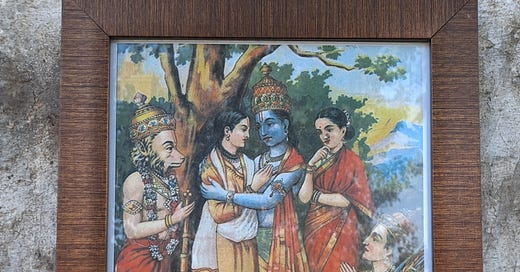



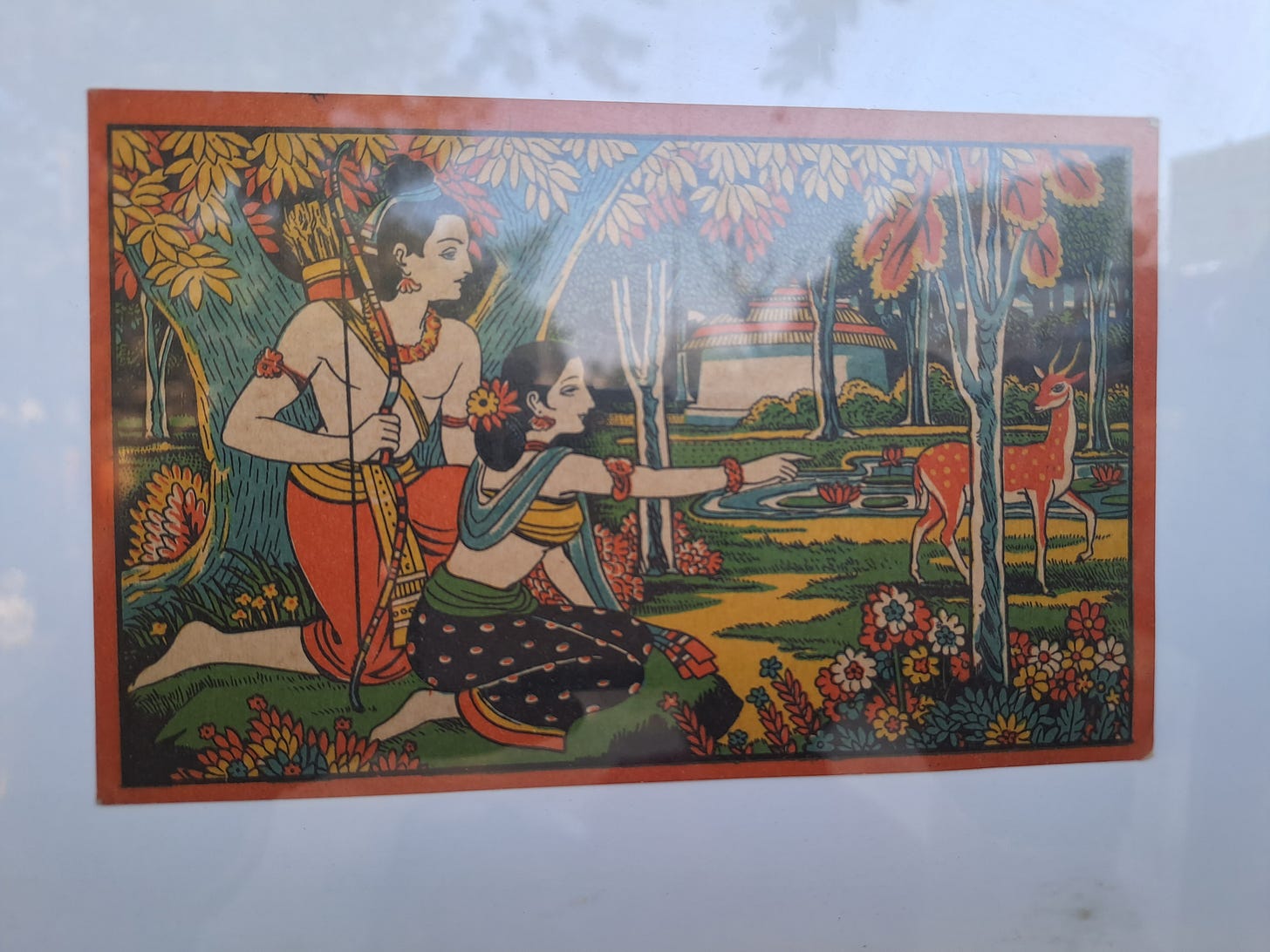
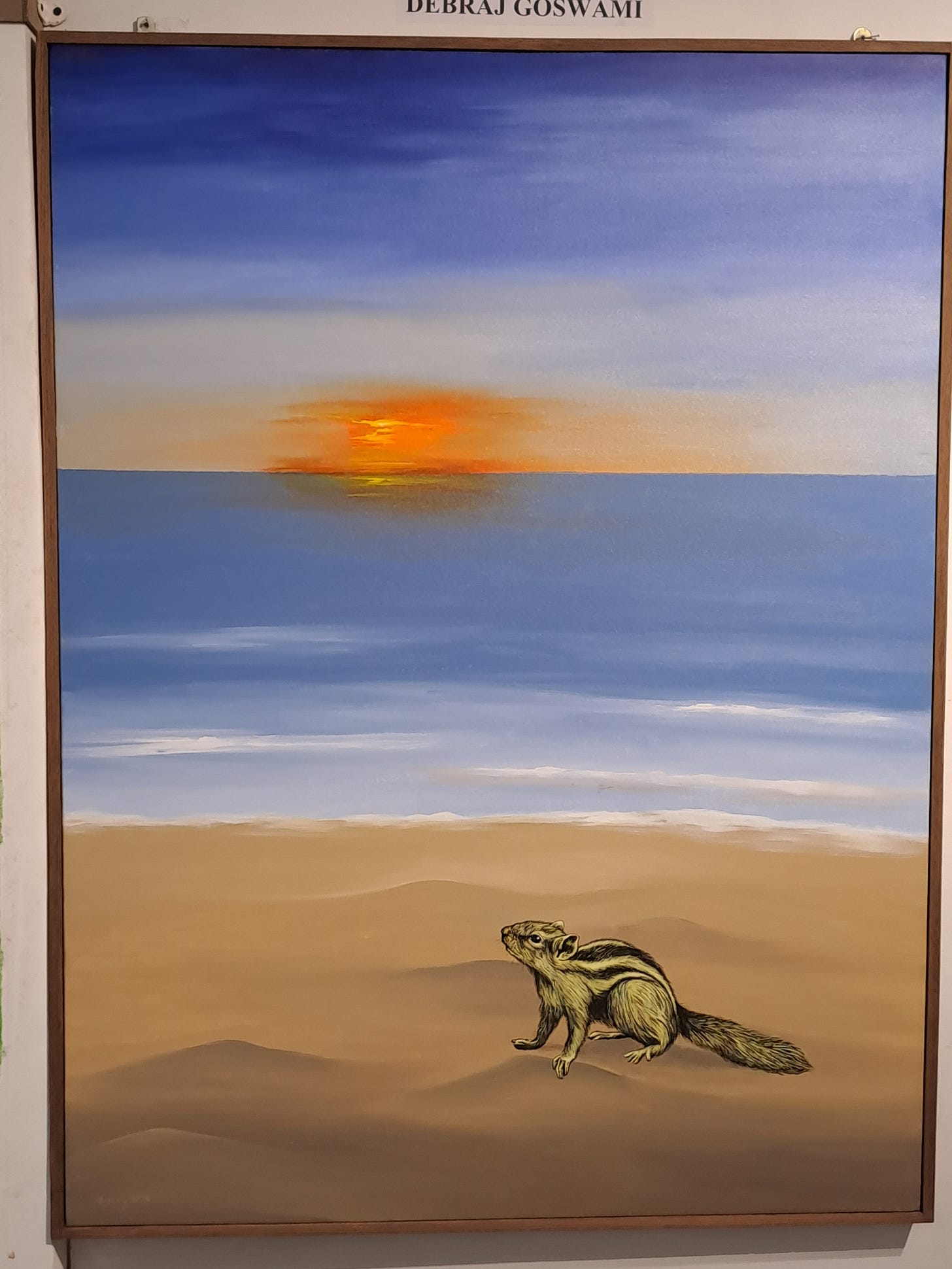
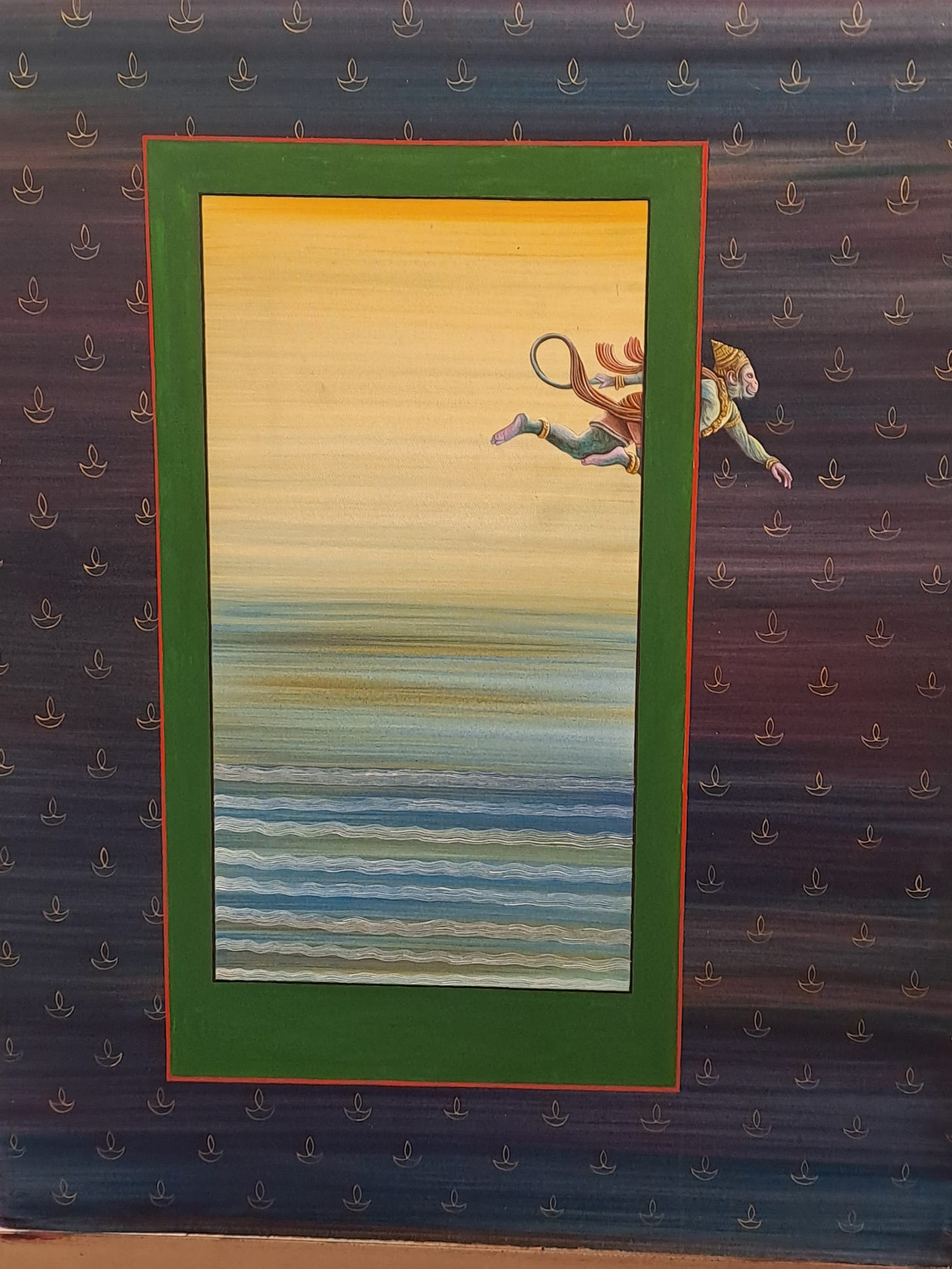
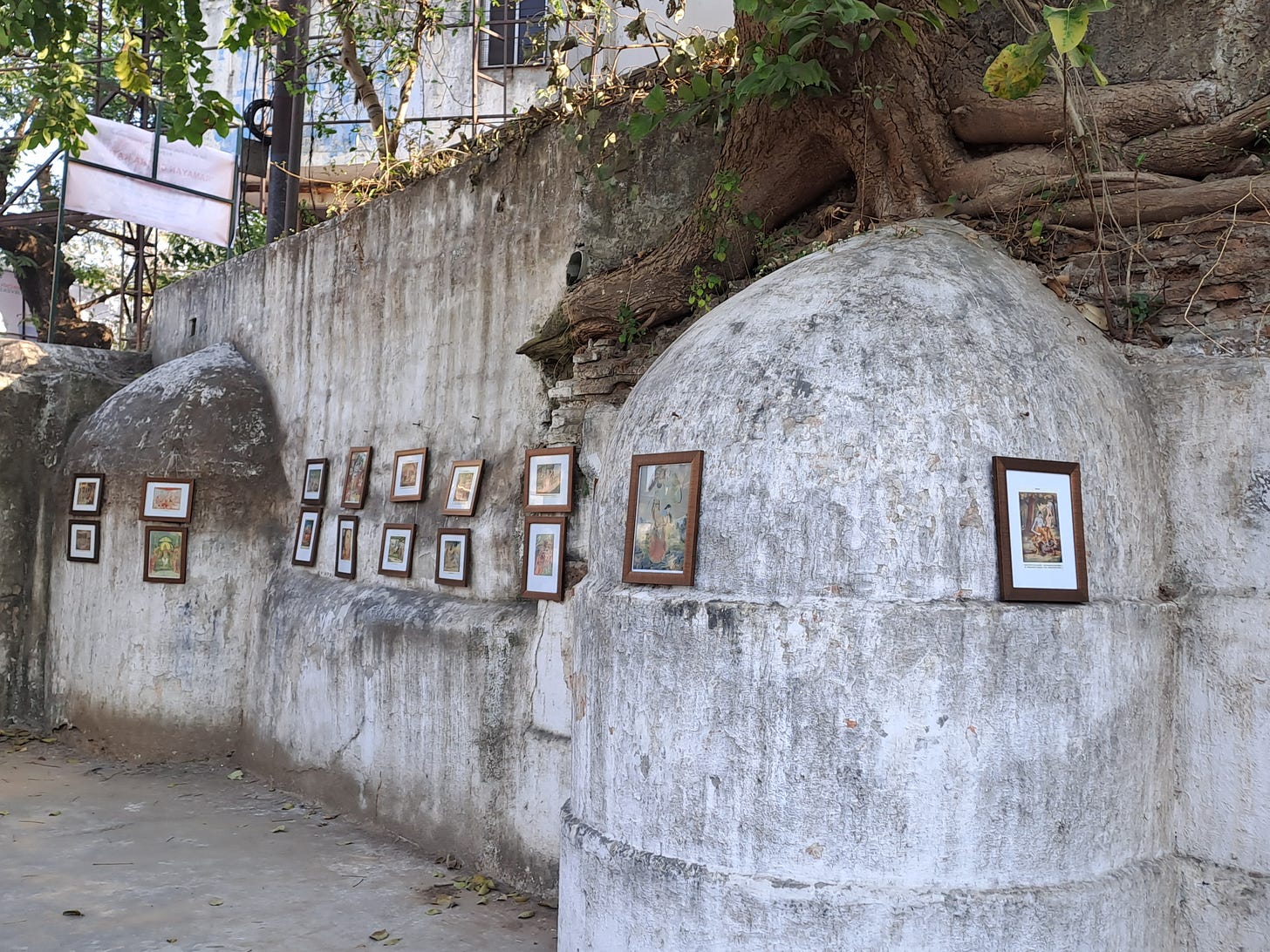
Enjoyed reading about Ram naam to handle scary situations especially regarding bhut pret and not Shiva name .Recent rekindling of Ram Bhakti in the entire Bharat is quite noteworthy.More of Ramayan events will be resurfacing and will be celebrated.Thanks for a nice easy narrative of recent celebrations